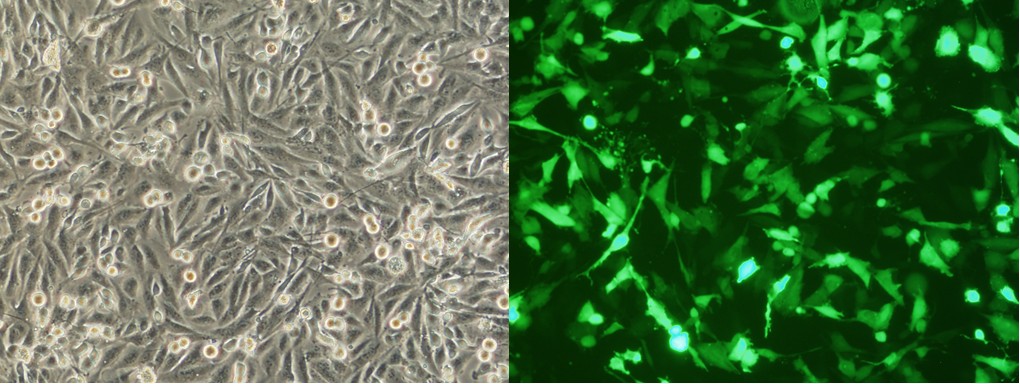Description
Cells to transfect:
Cell Line Name: U251
Cell Synonyms: NCI60, NCI-60, SNB19, U-373 MG, HTB-17
Patient’s Age: 75
Patient’s Sex: M
Tissue Type: CNS
Histology: Glioblastoma-ud; non epithelial, Pleomorphic/astrocytoid
p53 Status: 0
ECAD Methylation: 11
MDR Function: -19
Institution: Uppsala University, Sweden
Reference: Med Biol. 56:184-193, 1978
Biological source: Brain from human
growth mode: Adherent
karyotype: 2n = 46
receptors: PDGFR alpha and EGFR. See Nist®r M. et al., (1988) & (1991)
Comments: Derived from a malignant glioblastoma tumour by explant technique. U-251 was formerly distributed as U-373 MG (Sigma Catalogue number 89081403) until short tandem repeat (STR)-PCR profiling confirmed identity with U-251. SNB19 are derived with the same individual with U251.
U251 is one of the cell lines of the NCI-60 panel which represents different cancer types and has been widely utilized for drug screening and molecular target identification.
Transfection reagent features:
- Broad spectrum for the transfection of large plasmid, mRNA, siRNA, and/or other type of nucleic acids, which is best for co-transfection of different type and/or size of nucleic acids.
- Unique formulation-maximize transfection performance in U251 cells
- Extremely gentle to cells
- Much less reagent needed for each transfection: 0.5 ml is able to transfect about 1000 wells of 24-well plate
- Deliver single or multiple plasmids
- Free of animal-derived components
- Compatible with serum
- Suitable for Reverse Transfection
- Compatible with transfection in any plate format
- Developed and manufactured by EZ Biosystems
Data
FIG. 1. High throughput test of transfection efficiency (determined as RLU/mg) on U251 cells after transfection of luciferase reporter gene by using our 172 proprietary transfection formulas and several most popular commercial transfection reagents. The yellow box showed the results of 4 commercial transfection reagents. The red lines marked our candidate formulas with the highest transfection efficiency for U251 cells. This test result was confirmed with repeat experiments. The one that showed the optimal balance of potent & low cytotoxicity among those candidate formulas after flow cytometry analysis on the percentage of 7AAD positive cells was later named as this U251 Cell Avalanche® Transfection Reagent.
 FIG. 2. U251 cells were transfected with GFP vector (pEGFP-N3) by using U251 Cell Avalanche® Transfection Reagent. The cells were visualized by Nikon Eclipse Fluorescence microscope 24 hours post transfection.
FIG. 2. U251 cells were transfected with GFP vector (pEGFP-N3) by using U251 Cell Avalanche® Transfection Reagent. The cells were visualized by Nikon Eclipse Fluorescence microscope 24 hours post transfection.
For Other Cells
U251 Cell Avalanche® Transfection Reagent (human glioblastoma cell) can also be used on the following cells with high transfection efficiencies.
SF268 Cell
SF295 Cell
SNB75 Cell
SF539 Cell
MRC-5 Cell
IMR-90 Cell
COS-7 Cell
BHK-21 Cell
3197-3 Cell
NIH/3T3 Cell
Recommended protocols for these cells will be provided with the reagent. The protocols usually provide satisfactory transfection efficiency with invisible cytotoxicity. However, optimization may be needed for certain type of cells. Optimizations may include: the amount of DNA and this transfection reagent; cell density; transfection reagent/DNA ratio, or incubation time for the mixture of transfection reagent/DNA etc. For best transfection result, we recommend using the respective cell type/cell line specific Avalanche transfection reagents. Those reagents have been optimized on both recipes and protocols, and have been proved to have the best transfection results for the respective cell lines or primary cells. You can easily find the respective Avalanche transfection reagents specific for your cells by using the filters of our product list.
Additional Information
| Weight | 0.5 lbs |
|---|---|
| Adherence Phenotype |
Adherent |
| Cell Type |
Glial |
| Disease |
Cancer |
| Names starting from |
U |
| Primary/Cell Line |
Cell Line |
| Product Sizes |
0.5 ml, 1.5 ml |
| Species |
Human |
| Tissue Sources |
Brain |
| Subcategories |
Cell Type/Cell Line Specific |
Documents
Protocols
MSDS
Citations or Feedback
- Lipper, C. H., Gabriel, K. H., Seegar, T. C. M., Durr, K. L., Tomlinson, M. G., & Blacklow, S. C. (2022). Crystal structure of the Tspan15 LEL domain reveals a conserved ADAM10 binding site. Structure, 30(2), 206-214 e204. doi:10.1016/j.str.2021.10.007
- Turri, V., Latinovic, O. S., Bonafe, M., Toyang, N., Parigi, M., Calassanzio, M., . . . Martinelli, G. (2020). Cauliflower Mosaic Virus TAV, a Plant Virus Protein That Functions like Ribonuclease H1 and is Cytotoxic to Glioma Cells. Biomed Res Int, 2020, 7465242. doi:10.1155/2020/7465242



